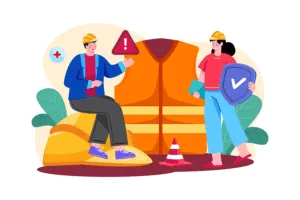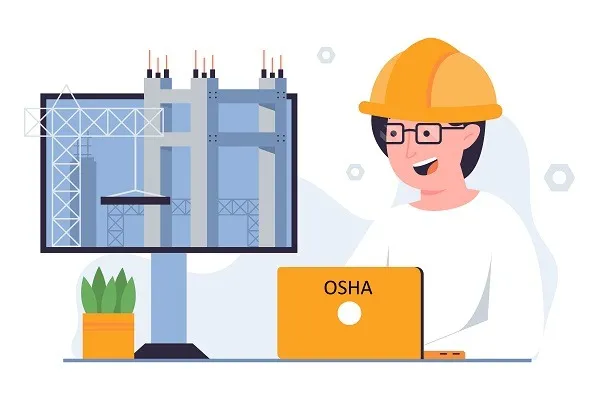OSHA: an Overview
The acronym “OSHA” stands for the “Occupational Safety and Health Administration.” Established in 1970 by the U.S. Congress, OSHA’s primary mission is to ensure safe and healthful working conditions for workers in the United States by setting and enforcing standards and providing training, outreach, education, and assistance.
Understanding OSHA is crucial for businesses, employees, and the general public to appreciate the importance of workplace safety and the roles and responsibilities that underpin it. This article provides a comprehensive understanding of OSHA’s establishment, goals, functions, and impact.
History
Before the creation of OSHA, workplace safety was inconsistent and largely unregulated at the federal level. Many industries operated without guidelines or oversight, leading to preventable accidents, injuries, and fatalities.
Recognizing the need for a central body to protect the rights of American workers and ensure a safer working environment, Congress passed the Occupational Safety and Health Act of 1970. This act created OSHA and positioned it under the U.S. Department of Labor.

OSHA’s Key Objectives
Setting Standards: OSHA has established numerous standards to guide employers and workers in maintaining a safe environment. These standards cover a wide range of hazards, from chemical exposures to machine safety.
Enforcement: Through inspections and penalties, OSHA ensures that employers adhere to the set standards. Employers found in violation might face fines or even legal action.
Training and Education: OSHA provides training programs and resources for employers and workers, ensuring that they have the knowledge and skills to maintain a safe work environment.
Outreach: This includes efforts to communicate and publicize the importance of workplace safety to the broader public and industries.
Partnerships and Cooperative Programs: OSHA collaborates with states, employers, and advocacy groups to foster shared responsibility in maintaining workplace safety.
Research: OSHA conducts and facilitates research to identify new hazards and refine existing safety protocols.
How OSHA Operates
OSHA functions at both federal and state levels. While the federal agency sets the overarching guidelines, many states operate their own safety and health programs, known as State Plans. These State Plans must be at least as effective as the federal OSHA program. They are monitored and funded in part by OSHA, ensuring a unified approach to workplace safety across the country.
Workplace Inspections

One of the primary ways OSHA enforces its standards is through inspections. These can be prompted by various factors:
Scheduled Inspections: Based on specific high-hazard industries or individual company histories with violations.
Worker Complaints: Employees have the right to report unsafe working conditions to OSHA. These complaints can trigger inspections.
Severe Injuries and Fatalities: Any workplace fatality or a specific number of hospitalizations due to work-related incidents mandates an inspection.
Referrals: Other government agencies, individuals, or organizations can alert OSHA to potential violations.
During these inspections, OSHA compliance officers evaluate the workplace’s adherence to safety standards, interview employees, and review documentation. If violations are discovered, citations can be issued, and fines may be levied.
Impact on Businesses and Workers
OSHA’s presence has reshaped American workplaces. For businesses, compliance with OSHA standards is not just about avoiding fines but also about protecting their most valuable assets: their employees. Safe workplaces have fewer accidents, which means lower medical costs, reduced workers’ compensation payments, and increased productivity due to fewer workdays lost.
For workers, OSHA provides a shield against hazardous conditions. The knowledge that there’s an agency dedicated to their safety empowers workers to voice concerns without the fear of retaliation, thanks to whistleblower protections.
Challenges and Criticisms
Like any agency, OSHA has faced challenges and criticisms. Some argue that OSHA’s regulations are too burdensome for businesses, particularly small enterprises that might struggle with the costs associated with compliance. Others believe that OSHA should be more stringent, pointing to persistent workplace hazards and accidents as evidence that the agency needs to be more aggressive in its approach.
Budget constraints and a vast number of workplaces to oversee mean that OSHA can’t inspect every business frequently. This limitation requires OSHA to prioritize its efforts, sometimes leading to criticism that certain sectors or businesses are overlooked.
The Future of OSHA
As industries evolve and new technologies emerge, OSHA must adapt to new types of workplace hazards. From the challenges of the gig economy, where traditional employer-employee relationships are blurred, to the advent of automation and AI, OSHA’s role will continue to be crucial in ensuring that American workers are protected.
Moreover, global pandemics, like the COVID-19 crisis, have underscored the importance of adaptable safety standards and the need for agencies like OSHA to guide businesses through unprecedented challenges.
In Conclusion
In essence, OSHA stands as a sentinel guarding the rights and well-being of American workers. Its inception marked a significant shift in the U.S. labor landscape, emphasizing the importance of worker safety and health. While the agency has faced challenges and criticisms over its half-century of operation, its impact is undeniable. Thousands of lives have been saved, and countless injuries prevented, all due to the standards and oversight provided by OSHA.
As we look towards the future, the need for an agency like OSHA becomes even clearer. With rapidly evolving workplaces and unforeseen challenges, having a dedicated body to navigate the complexities of occupational safety will remain paramount. OSHA’s legacy, therefore, is not just in its past achievements but in its future potential to protect and advocate for the American worker.




